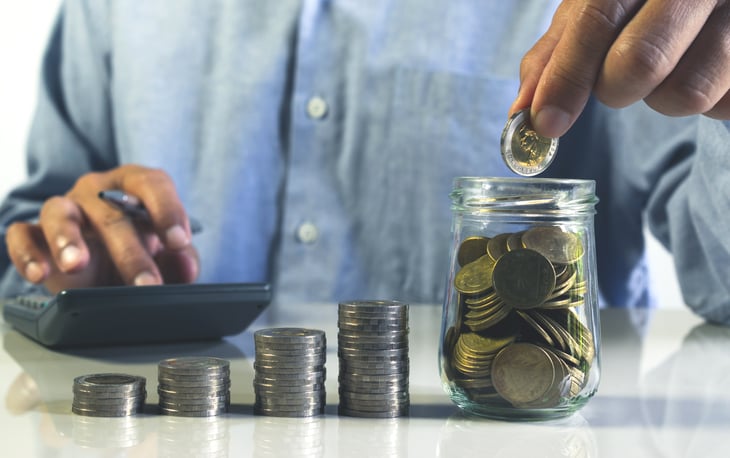
Editor's Note: This story originally appeared on Point2.
Someone’s savings can go towards any goal imaginable: a dream vacation, a large future purchase, or just covering everyone’s Christmas gifts. Unlike a savings account, the purpose of an emergency fund is the same for everyone: to help with unforeseen events.
Building a financial safety net is easier said than done when just over half of Americans aren’t able to cover a $1,000 unplanned expense. Today’s political climate and surging inflation only add to the uncertainty and difficulty in starting up an emergency fund — not to mention building one for a family.
If there’s anything we’ve learned from the pandemic, it’s that these precise struggles highlight the need for having an emergency fund in the first place — particularly for those with family to think of. Even if you’re an optimist born under a lucky star, think of it like this: best-case scenario, you never have to use that money. Read on to find out everything you need to know about setting up and building up a family emergency fund.
What’s a family emergency fund and why do I need one?

A family emergency fund does exactly what it says on the tin: It covers a household’s unexpected expenses. This separate savings account is dedicated to unplanned situations and is a fundamental part of most successful financial plans. Essentially, the money set aside can come in handy should you or your spouse lose your job, or need help in covering sudden health care costs.
Unexpected and sudden events might include:
- Loss of income/Unemployment
- Urgent medical treatment
- Death or disability in the family
- Boosts in monthly loan installments
- Necessary home improvements
- Emergency car repairs
In the wake of the pandemic, more and more Americans see the importance of having an emergency fund. Some lost their jobs, some lost their homes, and some dealt with health complications — and the road to rebuilding oneself after such hits is difficult. Using money from a fund dedicated to emergencies when dealing with the unexpected also reduces the need to use high-interest credit cards or take out loans to cover what’s needed. Basically, by tapping into your own savings, you eliminate further debt — it’s a safety cushion.
What qualifies as an emergency expense?

A family emergency fund ensures the well-being of the family members in the face of an unforeseen event. It focuses on essential needs and potential must-haves, usually revolving around loss of income or health events, rather than on setting an exact goal and saving up until you reached it (such as a family vacation).
Analyze your family’s monthly expenses and sort them into essential and discretionary. An essential expense might mean different things in different scenarios. For instance, if you’re expecting your first child, the jump from being a couple to having a baby to care for will make you reassess your essential expenses and shift your focus toward early childcare and school.
Even if you don’t have a spouse or children, a family emergency fund can come in handy as a way of providing financial aid to extended family members. For example, if you have aging parents, your emergency fund can aim to cover increasing medical expenses, assisted living costs, and even funeral expenses. Alternatively, a sibling might face an emergency of their own and require financial assistance. These days, emergency funds double as “worst-case-scenario” funds as some might even consider opening one to relocate in case of cultural unrest.
How large should my emergency fund be?

A quick Google search will tell you that the standard amount in an emergency fund should be somewhere between three to nine months’ worth of expenses. First off, figure out how much your family spends each month on necessary living expenses — including food, housing (mortgage, rent), utilities, school costs, car payments and insurance or other transportation costs, student loan payments, and other financial obligations.
Once you’ve identified your monthly essentials, you can put a plan in place to contribute part of your discretionary income to an emergency fund. And yes, putting aside nine months’ worth of household expenses is usually hard, not just this year. This requires serious effort and can be very straining on the average family’s budget, so starting with a more modest goal, like saving one month’s worth of expenses, can feel more manageable. Once you reach that goal, you’ll be able to reassess and adjust your contributions until you meet your overall goal. If you are paying off loans or credit cards at the same time, try to prioritize the high-interest debt first.
Building a solid emergency fund takes time, patience, and discipline from the entire family, so discuss a plan with them. Patience is crucial, and having a clear goal and buy-in from everyone makes the journey easier.
How long should I keep saving?

Short answer: however long it takes and makes you comfortable. In an ideal world, saving up for rainy days would be second nature, because life can throw curveballs when least expected — but that’s not always the case and it can be challenging to learn. After you reach your emergency fund goal, maintaining a steady balance becomes more about consistency rather than the amount set aside.
Understandably, many households with emergency funds set prior to the pandemic suddenly became unable to contribute as much or at all compared to pre-COVID-19 times. In times like these, budgeting and prioritization become even more important. For example, the average American household spends about $300 on eating out per month. Small perks such as takeout or daily coffee runs add up and can have an impact on your savings in the long run.
In the end, the best practice for maintaining an emergency fund is a mix of actively cutting specific costs, reigning in a few small luxuries, and allotting whatever possible regularly toward your goal. This includes smaller sums like unexpected refunds or extra change, to larger amounts like bonuses or raises from work.





Add a Comment
Our Policy: We welcome relevant and respectful comments in order to foster healthy and informative discussions. All other comments may be removed. Comments with links are automatically held for moderation.